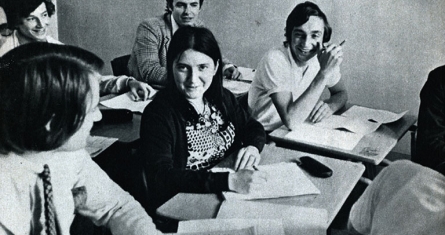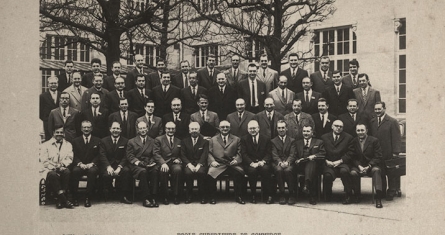Why Berlin?
10 Years Later
10 years later, the Paris Chamber of Commerce and Industry (CCIP) received a surprising proposal from the Senate of West Berlin, and more specifically from the CDU, the majority party in Parliament: to leave Düsseldorf behind and move to West Berlin, the western side of the former German capital.
Berlin's situation at the time
It is difficult for today’s young Europeans to imagine what the situation in Berlin was like at the time. It was a city in the middle of East Germany, cut in half by a wall and accessible only by plane, train and a motorway guarded by watchtowers and bordered by minefields. So the choice to move to East Germany surprised many. A great many students, especially German students, and their parents were deeply concerned by this change of location.
At the time, even the most optimistic could not imagine seeing the wall fall so rapidly, but the board of the school figured that in case of reunification, Berlin was better placed than Düsseldorf for the school to make a name for itself in Central Europe.
The Assistance from the Berlin Senate
The Senate of Berlin offered to contribute to financing for the future local EAP and, above all, proposed that the future EAP Berlin would eventually be recognised as a scientific academic institution under German law. One of the many practical consequence of this was the EAP's three-year period of schooling, two-thirds of which took place outside Germany, leading to the award of a "Diplom Kaufmann", a German university degree in management. At the time, no French Grande Ecole enjoyed such a status in Germany: all of them were classified as Fachhochhschulen, i.e. technology institutes or similar.
The recognition of the EAP as an academic institution under German law was finally promulgated in 1988.
Above and beyond their concrete benefits, from the CCIP's point of view the proposals of the Berlin Senate offered one outstanding quality in policy terms: they corresponded exactly to the original goal of the creation of the EAP, which was to build an entirely European institution in association with partners from other European countries.
In September 1985
In September 1985, the 11th class of EAP arrived in Berlin for their 3rd year of studies. The year consisted of 75 students, 50 French and 25 non-French.
They quickly got acclimatised at the school's premises on Breitscheidplatz, opposite the "Gedächtniskirche", in the heart of former West Berlin.i Although Berlin was a poor city, still marked by the destruction from the war and suffering from a high unemployment rate, rents were inexpensive and the nightlife was vibrant, thanks to the large population of young people and German students fleeing compulsory military service, which was not enforced in West Berlin.
They were supported by a faculty recruited according to the criteria of the German Ministry of Education and the students soon settled into the new Campus.
When Germany was reunified
The school fitted into the city well, so much so that in 1990, when Germany was reunified, the municipality of Berlin made a point of extending its gratitude to the school and the CCIP for "investing" in the future of the city at a time when no one could have dreamed of reunification.
Internships in Asia
A year earlier, the school experimented with internships in Asia, particularly in Thailand, for the edition of the first business and investment guide published at the MOCI. The change of perspective produced by the school’s immersion in the Asian landscape had a rallying effect on our common cultural platform, and helped to create the unique cultural experience of ESCP – but that is another story.
Gilles Gouteux, “Bicentenary” Project Manager, and Mark Grobien (EAP - class of 1986)
Our thanks to Bruno Leblanc, Dean of the EAP from 1979 to 1991, Véronique Girard (EAP 1985) and Caroline Brochard-Garnier (EAP 1986).
i The school subsequently moved to the Europa Center (Kurfürstendamm), before switching to its current location in Heubnerweg


